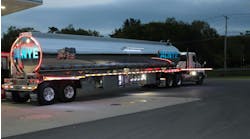The ink was hardly dry on 2022’s best-ever financial results when publicly traded trailer and truck body manufacturer Wabash again rewrote its record book. The Wabash year-end 2023 financial statement contained all-time highs for annual sales, operating income, and earnings per share, the company reported on Feb. 1.
“During 2023 we’ve substantially exceeded the financial performance in any year of the company’s history,” Wabash President and CEO Brent Yeagy said. “Beyond our financial accomplishments, I’m even more excited about the strategic progress we made during 2023 and how it positions us to generate stronger results going forward for our employees, our customers, and our other stakeholders. Our execution is allowing us to achieve higher levels of financial performance through all phases of the cycle, and we are confident that when market conditions strengthen for our customers, we will deliver financial performance that exceeds 2023.”
For the quarter, net sales were $596 million. Operating income was $61.1 million, or 10.3% of sales. For the full year 2023, revenue totaled $2.5 billion with operating income of $311.9 million, or 12.3% of sales. While annual sales just topped 2022’s record, operating income for the year was up 87%.
Total backlog as of Dec. 31, 2023, was approximately $1.9 billion, which was “steady” compared to the prior quarter. Backlog expected to be shipped within the following 12 months was $1.6 billion—a $100 million increase from the prior quarter, the company reported.
How Wabash did it
Yeagy emphasized the company’s focus on “connections, relationships, and networks” in discussing the Q4 results with investment analysts, pointing to enhanced dry van capacity, greater focus on parts and services, as well as “innovative offerings” such as trailers-as-a-service.
“By gaining a more profound understanding of our customer problems and their opportunities, we are more able to share valuable insights with our suppliers, our technology partners, and other parties that can contribute to customer success,” Yeagy said.
Additionally, he noted that Wabash is positioned to post higher levels of financial performance through “all phases of the cycle.”
“We are confident that when the market conditions strengthen for our customers, we will achieve financial performance that exceeds 2023,” Yeagy said.
Outlook for company, customers
While the financial performance forecast for Wabash this year is “a moderation” from 2023’s record performance, Yeagy noted that the midpoint of Wabash’s 2024 earnings guidance is “in line” with the results from 2022, the second-best annual financial performance in the company’s history. And such a result would “easily” be the best when facing “the headwinds of a difficult market.”
Read more: Wabash Q3 report: 'Ready to take it to the next level'
Still, the freight market is beginning “to heal and correct itself,” with measurable improvement for fleet customers “probably by midsummer”—assuming interest rates continue to moderate and that the status quo can be maintained from a “geopolitical” standpoint.
“The things that the U.S. economy is acting on sets us up for a much better 2025,” Yeagy said. “Can we see a significant demand difference in 2025? I believe that to be the case. I think you’ll see that robustness build throughout 2025, and I think it can be material. We are planning our business based off of that being the most probable outcome.”
Segment highlights
During the fourth quarter, Transportation Solutions achieved net sales of $547 million, a decrease of 10.5% compared to the same quarter of the previous year. For the full year, net sales came in at $2.34 billion, an increase of 0.8%. Adjusted operating income for the quarter amounted to $74.6 million, representing 13.6% of sales. For the full year, adjusted income was $367 million, up 75%.
For Q4, Wabash shipped 10,075 trailers, compared to 13,135 trailers for the period last year (a 23.3% decrease). For the full year, Wabash shipped 44,450 trailers, down 14.6% compared to 52,035 trailers in 2022. Truck body shipments for the quarter were 4,075, up from 3,250 (a 25.4% increase). For the year, Wabash shipped 16,070 truck bodies, up 8.6% compared to 14,800 truck bodies in 2022.
Wabash Senior Vice President and CFO Mike Petit cited the 12-month backlog, along with new order activity in January, as the basis for the company’s 2024 outlook.
“We continue to expect truck body, tank trailers, and Parts & Services to serve as stabilizing forces in 2024 as market conditions remain stronger in those businesses relative to dry vans,” he said. “Additionally, these businesses have and will continue to benefit from organizational focus and execution. Tank trailers and truck bodies have both experienced improved volumes as we act on the business through our Wabash Management System.”
Parts & Services’ net sales for the fourth quarter reached $55.2 million, an increase of 11.2% compared to the prior year quarter. For the full year, Parts & Services’ net sales came in at $220.9 million, a 14.2% increase.
Yeagy noted that the segment is on track to reach a target of $300 million in 2025.
“As we continue to grow in Parts and Services, we’re not doing it in the same old blocking-and-tackling way,” the president and CEO said. “The way that we’re attacking the market is really going after the unserved areas, which allows us some blue-ocean capabilities to grow, and that’s all on purpose. There’s no need to jump into the pool with everyone else. We need to find a new pool.”












